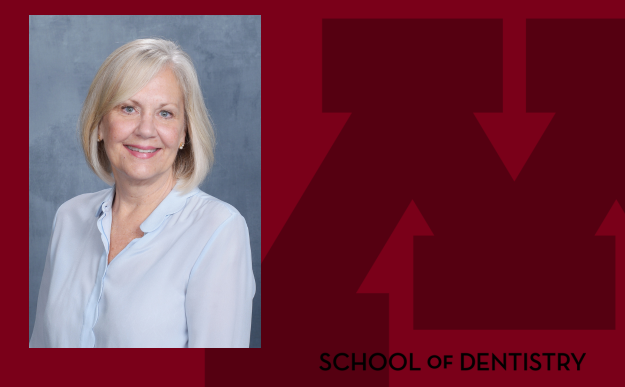Christine Blue retires after nearly 30 years of service in dental hygiene

Christine Blue, DHSc, MS, RDH, associate professor in the Department of Primary Dental Care and Assistant Dean for Faculty Development, retired from the School of Dentistry in December after nearly 30 years of service.
After graduating from the University of Minnesota’s dental hygiene program herself, Blue received a Bachelor of Science and a Master of Science in Dental Hygiene from Old Dominion University and earned a doctorate in health sciences from A.T. Still University. She joined the School of Dentistry faculty in 1994 and became director of the Division of Dental Hygiene in 2005.
In 2013, Blue was promoted to associate professor with tenure. In 2020, she created the role of—and became the first to serve as—Assistant Dean of Faculty Development. She has held several leadership roles, taught hundreds of students and positively shaped the research, learning and patient care of the school throughout her tenure.
When she reflects back on her many accomplishments at the School of Dentistry, she is particularly proud of the ways she has changed the future of education. From instituting the Master of Science in Dental Hygiene program in the 2000s to creating a study abroad exchange program for dental hygiene learners with the University of Bergen to increasing faculty research and celebrating the 100th anniversary of dental hygiene at the school, Blue opened new horizons for dental hygiene learners and celebrated the history that brought them there.
As one of the initial members of the group tasked with implementing a dental therapy program in Minnesota, Blue traveled to New Zealand, Canada and the United Kingdom to understand the profession. “Never in my imagination did I think that my career would take me all over the world” she reflected. A career highlight for Blue was supporting a team care model of oral health delivery in the school’s clinic. The new delivery model maximized the skills of every student provider: dental therapist, dental hygienist and dentist with the goal of increased efficiency and cost effectiveness.
“We became a model for the rest of the country, and other dental schools sent representatives here to witness the team care clinic in action,” she recalled. “I have fond memories of that.”
In addition to her great accomplishments in education, Blue was instrumental in providing financial support for students. As Division Director, Blue partnered with the Development Office to raise $1,450,763 in support of the division, and she was involved in the creation of four new scholarships for dental hygiene learners.
“Donations allowed us to purchase equipment to do clinical research, send faculty to professional meetings, support student activities, establish the study abroad program and more,” she recalled. “I wouldn’t have been able to offer these opportunities to faculty or students without the support of our alumni. It always amazes me how generous our dental hygiene alumni are.”
But above all, Blue hopes she’s made a real impact on the people around her. “I hope that my legacy is to have grown leaders in the dental hygiene profession ,” she said. “I’ve loved all my roles here in the School of Dentistry, division director, MSDH graduate program director, and now assistant dean for faculty development. I take pride in the fact that most of the dental hygiene faculty are former students of mine, and I hope I’ve grown leaders both here and outside these walls.”
Judging by the reception she received at a celebration of her retirement, Blue’s goal has been a great success.
“There are 330 million Americans, approximately 200,000 of whom are licensed dental hygienists who graduated from 325 United States dental hygiene education programs, and I can say without any bias that Dr. Blue created the number one program in the country,” said Sheila Riggs, DDS, MS, DMSc, chair of the Department of Primary Dental Care. “We have always had a strong program, but she was at the heart of the dental therapy program and the MSDH program. Her profound impact on the health of Minnesota communities will be felt for generations.”